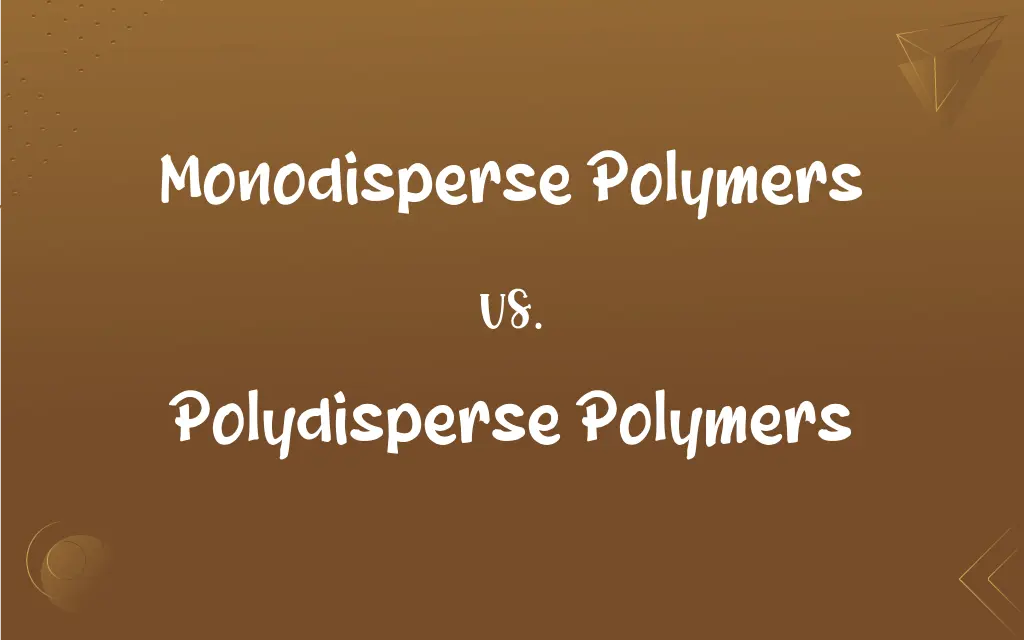Monodisperse Polymers vs. Polydisperse Polymers: What's the Difference?
Edited by Aimie Carlson || By Harlon Moss || Published on February 4, 2024
Monodisperse Polymers are polymers with uniform molecular weight and size distribution. Polydisperse Polymers are polymers with a wide range of molecular weights and size distribution.

Key Differences
Monodisperse polymers are characterized by their uniform molecular weight and size distribution, meaning each polymer chain is nearly identical in length. Polydisperse polymers, in contrast, exhibit a wide range of molecular weights, resulting in a mixture of chain lengths.
The synthesis of monodisperse polymers often involves controlled methods to ensure uniformity, whereas polydisperse polymers are typically produced through conventional polymerization techniques which result in varied chain lengths.
In monodisperse polymers, the consistency in molecular weight allows for predictable physical and chemical properties, making them ideal for precise applications. Polydisperse polymers, with their varied chain lengths, exhibit a broader range of properties.
Applications of monodisperse polymers are often found in high-performance materials where uniformity is crucial, such as in biomedical devices. Polydisperse polymers are more common in everyday products like plastics and rubbers.
The production of monodisperse polymers is generally more complex and costly than that of polydisperse polymers, due to the need for precise control over the polymerization process.
ADVERTISEMENT
Comparison Chart
Molecular Weight Distribution
Uniform
Wide range
Synthesis Methods
Controlled, precise techniques
Conventional polymerization
Physical and Chemical Properties
Predictable and consistent
Broad and varied
Typical Applications
High-performance materials
Everyday products
Production Complexity
High, requiring precision
Less complex, more common
ADVERTISEMENT
Monodisperse Polymers and Polydisperse Polymers Definitions
Monodisperse Polymers
Single-size polymer chains with minimal molecular weight variation.
The experiment required monodisperse polymers to study specific molecular interactions.
Polydisperse Polymers
Non-uniform polymer chains with a wide size distribution.
The polydisperse polymers in the composite material contributed to its multifunctional characteristics.
Monodisperse Polymers
Polymers with identical chain lengths and uniform molecular weight.
Monodisperse polymers were used to create a consistent coating for the medical device.
Polydisperse Polymers
Polymers produced through conventional techniques with varied sizes.
In manufacturing, polydisperse polymers are often used due to their easier production.
Monodisperse Polymers
Polymers synthesized with controlled methods for uniformity.
The research focused on monodisperse polymers for their predictable properties.
Polydisperse Polymers
Varied chain length polymers common in everyday products.
The rubber tire was made from polydisperse polymers to balance strength and flexibility.
Monodisperse Polymers
Polymers where each molecule is almost the same size.
Monodisperse polymers ensured the consistency of the optical materials produced.
Polydisperse Polymers
Polymers with a range of molecular weights and chain lengths.
The polydisperse polymers provided a variety of physical properties for the plastic blend.
Monodisperse Polymers
Uniform polymers ideal for precision applications.
In nanotechnology, monodisperse polymers are essential for building accurate nanostructures.
Polydisperse Polymers
Polymers exhibiting a broad spectrum of molecular weights.
Polydisperse polymers were chosen for the coating due to their diverse functional properties.
FAQs
What defines a monodisperse polymer?
Uniform molecular weight and chain length.
What synthesis methods are used for polydisperse polymers?
Conventional, less controlled polymerization techniques.
Why are monodisperse polymers important in nanotechnology?
Their uniformity is crucial for building precise nanostructures.
What applications suit polydisperse polymers best?
Everyday products like plastics and rubbers.
Are monodisperse polymers common in everyday products?
They are less common due to their complex production.
How are monodisperse polymers synthesized?
Through controlled, precise polymerization methods.
What makes polydisperse polymers versatile?
Their varied molecular weights and applications.
Are monodisperse polymers better for high-performance materials?
Yes, due to their uniformity and predictability.
What are polydisperse polymers?
Polymers with varied molecular weights and sizes.
How do polydisperse polymers affect product performance?
They offer a balance of properties due to their molecular variety.
Can polydisperse polymers have consistent properties?
No, their properties vary due to the range of chain lengths.
Are monodisperse polymers used in medical devices?
Yes, their consistency is crucial for biomedical applications.
How do polydisperse polymers behave in chemical reactions?
Their behavior is less predictable due to size variation.
What is the impact of molecular weight on polydisperse polymer properties?
It leads to a broad range of physical and chemical behaviors.
Can monodisperse polymers be produced on a large scale?
It's challenging due to the complexity of their synthesis.
How do environmental factors affect polydisperse polymers?
They can influence the polymers' diverse properties differently.
Is the production of monodisperse polymers costly?
Yes, due to the need for precise control.
Can polydisperse polymers be tailored for specific uses?
To some extent, but with less precision than monodisperse polymers.
Do monodisperse polymers exhibit a broad range of properties?
No, their properties are predictable and consistent.
What challenges exist in synthesizing monodisperse polymers?
Achieving precise control over molecular weight and distribution.
About Author
Written by
Harlon MossHarlon is a seasoned quality moderator and accomplished content writer for Difference Wiki. An alumnus of the prestigious University of California, he earned his degree in Computer Science. Leveraging his academic background, Harlon brings a meticulous and informed perspective to his work, ensuring content accuracy and excellence.
Edited by
Aimie CarlsonAimie Carlson, holding a master's degree in English literature, is a fervent English language enthusiast. She lends her writing talents to Difference Wiki, a prominent website that specializes in comparisons, offering readers insightful analyses that both captivate and inform.































































